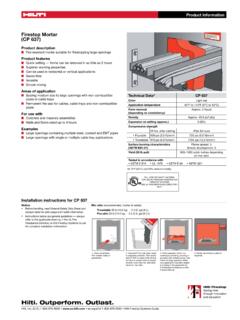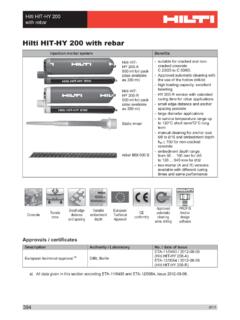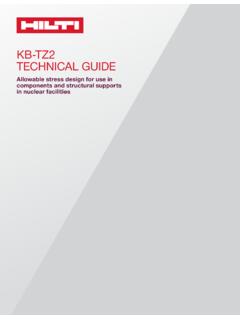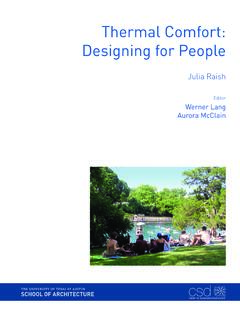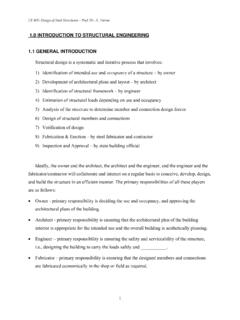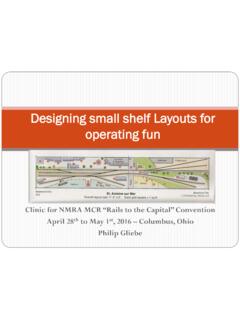Transcription of Designing anchors with HIT-RE 500 V3 using core drilled ...
1 Hilti, Inc. 7250 Dallas Parkway, Suite 1000 Plano, TX 75024 1-800-879-8000 Designing anchors with HIT-RE 500 V3 using core drilled holes with large annular gap Revised July 26, 2021 Hilti has published technical data for the Hilti HIT-RE 500 V3 adhesive anchoring system which can be used for post-installed threaded rod installations for anchor design in accordance with ACI 318 Chapter 17 and CSA Annex D. Current published information is based on testing in accordance with ACI and ICC-ES Acceptance Criteria for Post-Installed Adhesive anchors in Concrete Elements, (AC308) and can be found in ESR-3814 and in section of the Hilti North American Product Technical Guide Volume 2: Anchor Fastening Technical Guide, Edition 21 (PTG Ed.)
2 21). The published values in ESR-3814 and the PTG Ed. 21 correspond to testing performed in accordance with the published Instructions for Use (IFU). Hilti has performed additional testing in diamond core drilled holes with a core bit diameter, do, of * da (da is the nominal threaded rod diameter) in accordance with ACI and AC308. The design information presented in the tables below is based on this additional testing and the technical data in the tables is intended to be used in conjunction with a full anchor design in accordance with ACI 318 Chapter 17 or CSA Annex D. See ESR-3814 and the PTG Ed. 21 for more design information for additional information that may be needed for a full design calculation.
3 No testing has been performed in hammer drilled holes, however, using the assumptions below is expected to represent a conservative approach. Hilti, Inc. 7250 Dallas Parkway, Suite 1000 Plano, TX 75024 1-800-879-8000 Table 1 Bond strength design information for HIT-RE 500 V3 with fractional threaded rods in holes core drilled with a diamond core bit in accordance with ACI 318 Chapter 171 DESIGN INFORMATION Symbol Units Nominal rod diameter (in.) 3/8 1/2 5/8 3/4 7/8 1 1-1/4 Maximum nominal core bit diameter do in. 9/16 3/4 7/8 1-1/8 1-1/4 1-1/2 1-7/8 Minimum embedment hef,min in. 2-3/8 2-3/4 3-1/8 3-1/2 3-1/2 4 5 Maximum embedment hef,max in. 7-1/2 10 12-1/2 15 17-1/2 20 25 Minimum member thickness hmin in.
4 Hef + 1-1/4 hef + 2d0(7) Critical edge distance-splitting (for uncracked concrete) cac - See Section of ESR-3814 Min. edge distance6 cmin in 5d; or see Section of this ESR-3814 for design with reduced minimum edge distances Min. anchor spacing6 smin in 1-7/8 2-1/2 3-1/8 3-3/4 4-3/8 5 6-1/4 Effectiveness factor for uncracked concrete kc,uncr - 24 Strength reduction factor for tension, concrete failure modes, Condition B5 - Strength reduction factor for shear, concrete failure modes, Condition B5 - Dry concrete & water saturated concrete Temperature range A2 Characteristic bond strength in uncracked concrete Short term load conditions4 k,uncr psi 1,550 1,550 1,550 1,550 1,550 1,550 1,550 Characteristic bond strength in uncracked concrete Sustained load conditions3 k.
5 Uncr psi 480 480 480 480 480 480 480 Temperature range B2 Characteristic bond strength in uncracked concrete Short term load conditions4 k,uncr psi 730 730 730 730 730 730 730 Characteristic bond strength in uncracked concrete Sustained load conditions3 k,uncr psi 230 230 230 230 230 230 230 Anchor Category - - 2 2 3 3 3 3 3 Strength Reduction factor d, ws - For SI: 1 inch mm, 1 lbf = N, 1 psi = MPa. For pound-inch units: 1 mm = inches, 1 N = lbf, 1 MPa = psi 1 Bond strength values correspond to concrete compressive strength f c = 2,500 psi ( MPa). For concrete compressive strength, f c, between 2,500 psi ( MPa) and 8,000 psi ( MPa), the tabulated characteristic bond strength may be increased by a factor of (f c / 2,500) for uncracked concrete [For SI: (f c / ) ].
6 See Section of this ESR-3814 for bond strength determination. 2 Temperature range A: Maximum short term temperature = 130 F (55 C), Maximum long term temperature = 110 F (43 C). Temperature range B: Maximum short term temperature = 176 F (80 C), Maximum long term temperature = 110 F (43 C). Short term elevated concrete temperatures are those that occur over brief intervals, , as a result of diurnal cycling. Long term concrete temperatures are roughly constant over significant periods of time. 3 Characteristic bond strength values are for sustained load combinations including dead and live loads. 4 Characteristic bond strength values are for load combinations consisting of short term loads only, such as wind and seismic 5 Values provided for post-installed anchors under Condition B without supplementary reinforcement.
7 6 For installations with 1-3/4-inch edge distance, refer to Section of ESR-3814 for spacing and maximum torque requirements. 7 d0 = hole diameter. Hilti, Inc. 7250 Dallas Parkway, Suite 1000 Plano, TX 75024 1-800-879-8000 Table 2 Bond strength design information for HIT-RE 500 V3 with fractional threaded rods in holes core drilled with a diamond core bit in accordance with CSA Annex D1 DESIGN INFORMATION Symbol Units Nominal rod diameter (in.) 3/8 1/2 5/8 3/4 7/8 1 1-1/4 Maximum nominal core bit diameter do in. 9/16 3/4 7/8 1-1/8 1-1/4 1-1/2 1-7/8 Minimum embedment hef,min mm 60 70 79 89 89 102 127 Maximum embedment hef,max mm 191 254 318 381 445 508 635 Minimum member thickness hmin mm hef + 30 hef + 2d0(7) Critical edge distance-splitting (for uncracked concrete) cac - See Section of ESR-3814 Min.
8 Edge distance6 cmin mm 5d; or see Section of ESR-3814 for design with reduced minimum edge distances Min. anchor spacing6 smin mm 48 64 79 95 111 127 159 Effectiveness factor for uncracked concrete kc,uncr - 10 Concrete material resistance factor - Resistance modification factor for tension and shear, concrete failure modes, Condition B5 R - Dry concrete & water saturated concrete Temperature range A2 Characteristic bond strength in uncracked concrete Short term load conditions4 k,uncr MPa Characteristic bond strength in uncracked concrete Sustained load conditions3 k,uncr MPa Temperature range B2 Characteristic bond strength in uncracked concrete Short term load conditions4 k.
9 Uncr MPa Characteristic bond strength in uncracked concrete Sustained load conditions3 k,uncr MPa Anchor Category - - 2 2 3 3 3 3 3 Resistance modification factor for bond failure modes Rd, Rws - For SI: 1 inch mm, 1 lbf = N, 1 psi = MPa. For pound-inch units: 1 mm = inches, 1 N = lbf, 1 MPa = psi 1 Bond strength values correspond to concrete compressive strength f c = 2,500 psi ( MPa). For concrete compressive strength, f c, between 2,500 psi ( MPa) and 8,000 psi ( MPa), the tabulated characteristic bond strength may be increased by a factor of (f c / 2,500) for uncracked concrete [For SI: (f c / ) ].
10 See Section of ESR-3814 for bond strength determination. 2 Temperature range A: Maximum short term temperature = 130 F (55 C), Maximum long term temperature = 110 F (43 C). Temperature range B: Maximum short term temperature = 176 F (80 C), Maximum long term temperature = 110 F (43 C). Short term elevated concrete temperatures are those that occur over brief intervals, , as a result of diurnal cycling. Long term concrete temperatures are roughly constant over significant periods of time. Characteristic bond strengths are for sustained loads including dead and live loads. For load combinations consisting of short term loads only, such as wind and seismic, bond strengths may be increased by 320%.


